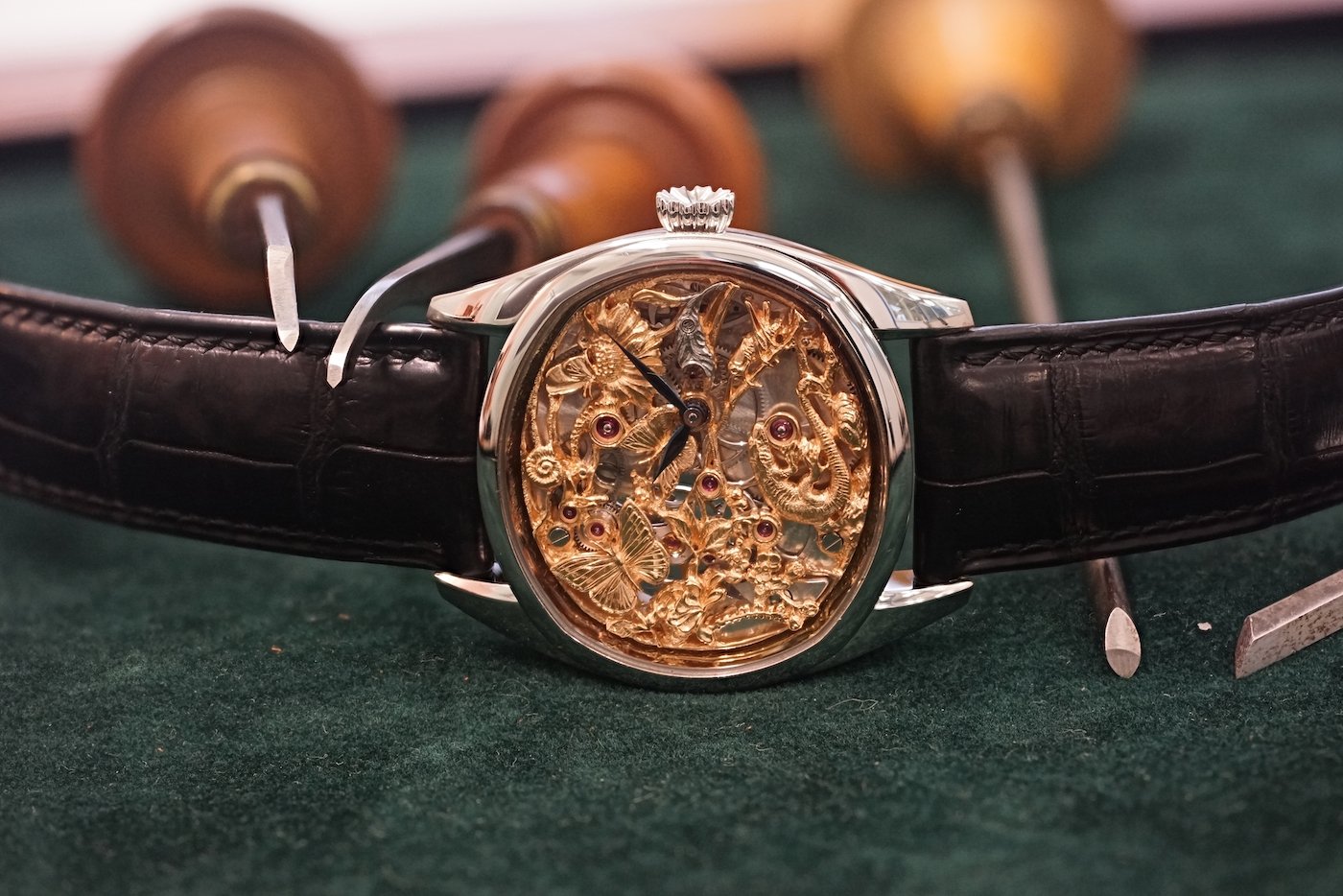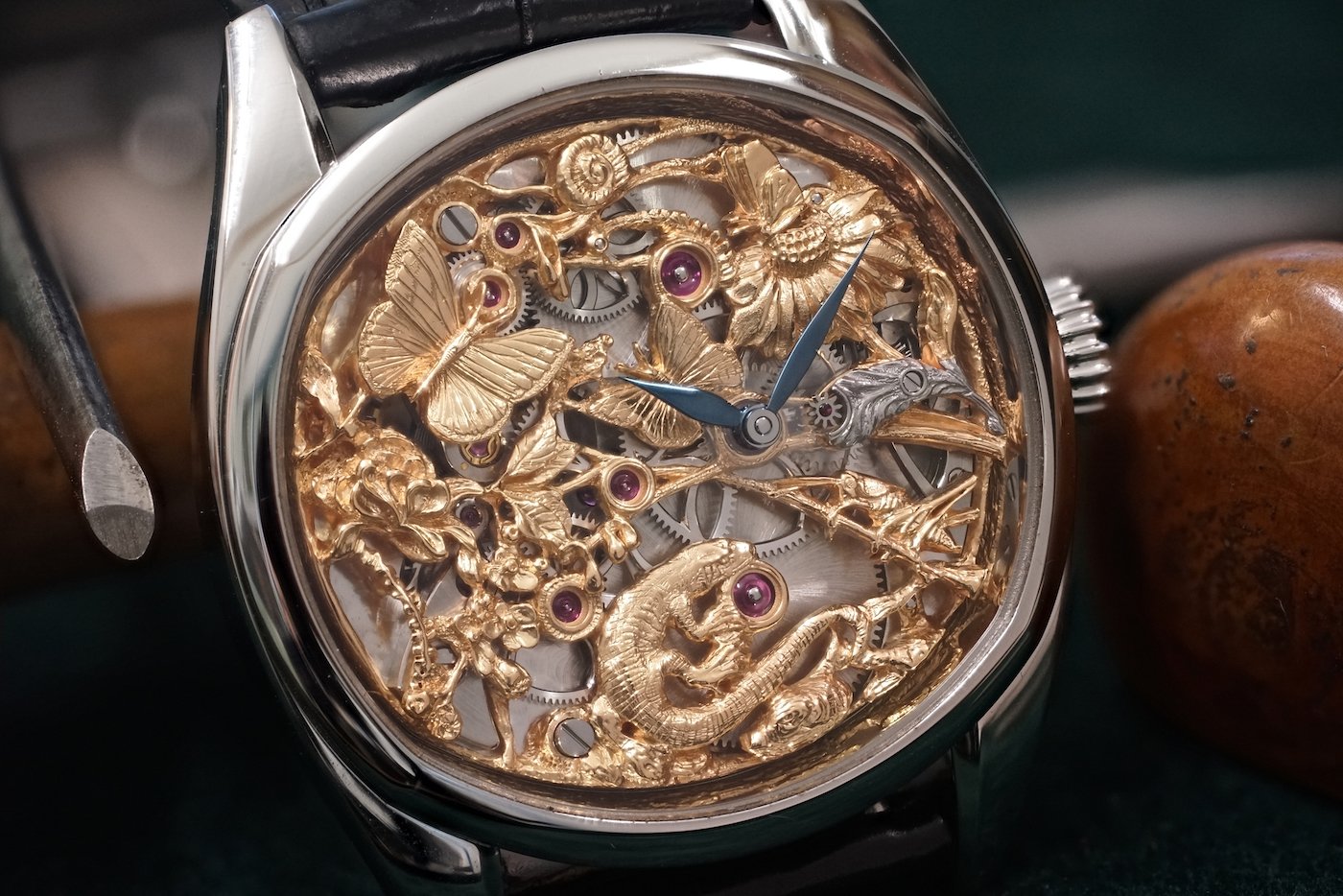ngraving, incising a design on a hard, usually flat surface by cutting grooves into it with a burin has existed before us. Already our ancestors, i.e. the ancestors of homo sapiens have known it. Until today, the art has made great progress but the objects, animals and plants, are still a popular subject.
As UhrTeil AG, the manufacturing arm of Andreas Strehler, employs Roman Houdek, a master engraver, Andreas had the idea of a collaboration for his own watches to showcase both the engraving skills of Roman and the watchmaking skills of Andreas in a combined creation.
Floral motifs in an abstract form as well as the butterfly bridges are familiar motifs on Andreas Strehler watches. This logically led to the creation of the Faune et Flore collection, representing the fauna and flora in miniature works of art in an Andreas Strehler watch.
In a watch, and not on a watch, as the not only an engraved dial was to put on a watch but the engraving and the watch and in particular the watch movement were to become a unit, one being an integral part of the other.

After Andreas’ idea and detailed explanations, Roman begins to make the first sketches traditionally by hand. He uses photos of the animals chosen as the motif for the watch’s central bridge and hence its dial as inspiration and as a template. It is important that the proportions and movement of the animals match the living model.
Once the basic idea has been formed, the design is worked out on the computer to ensure that the positions of the animals and plants do not cover up important positions for the function of the watch movement. During this time, the collaboration with Andreas is particularly intensive to ensure that the result fulfils Andreas’ requirements.
Once the design has been finalised, a plate of massive 18k gold with the correct thickness and size to fit inside an Andreas Strehler watch is machined and used as a basis for the engraving. This already has all the precisely drilled holes required for the later placement of the jewels.
The master engraver then transfers the contours of the later motifs to this bridge before scribing them with his ‘Spitzstichel’ (pointed burin) These light lines serve as markings for the subsequent actual engraving. Using his ‘Bollstichel’ (hollow burin), ‘Flachstichel’ (flat burin), ‘Spitzstichel’ and other burins and tools in different sizes, he first roughly removes the raw material from the blank before turning his attention to the details of the motif. With his experience and talent, he creates a three-dimensional image of nature, turning metal into a living thing, step by step.
All engravings on the Faune et Flore watches are done entirely by hand; the computer is initially only used to draft the design and to ensure that the correct position of the jewels and therefore the functioning of the watch movement.
The first watch of the series is the Jardin des Papillons. Obviously, the butterfly, Andreas Strehler’s heraldic animal, had to be the first to be immortalised on an Andreas Strehler watch. For Native Americans, butterflies are a symbol of rebirth and transformation and therefore of hope. In the Chinese culture, the butterflies stand for love, beauty, freedom, and the human soul.
In the Jardin des Papillon, the butterfly was set in a garden with other animals and floral ornaments to give it a beautiful background and context. Looking at the finely sculptured landscape full of small animals evokes a garden in summer, with the scent of flowers and the sound of a mild breeze rustling the leaves.

With the Étang des Koï, Andreas Strehler changed the element and a bit the continent but remained true to his ideas of design and beauty. In the Japanese language, “koi” is a homophone for 恋, a sign which means “love” and “affection”. This is the reason why koi are symbols of love and friendship.
Ornamental koi are also symbolic of the whole Japanese culture and are still closely associated with Japan’s national identity. Well-known are the koinobori called carp streamers. This tradition began in the Edo period (1603–1867) and is still practiced today, when on 5 May, Children’s Day, colourful carp-shaped wind-socks made out of paper or cloth flutter in the wind.
The Étang des Koï evokes a tranquil pond for the koi to live in peacefully, move slowly and invite contemplation and meditation. Standing in a sculptured Japanese garden, looking at the tranquil pond with the sound of a spring gently burbling in the background was the feeling the master engraver brought to live in this masterpiece.
One whole month, or cautiously calculated at 20 working days with 8 working hours, 160 hours is the time it takes to turn bridges at the hand of a master engraver into a living object. 200 plus hours is probably more like it. The work of the engraver takes skill and experience and great concentration. A single wrong movement with his burin can irretrievably destroy the work of weeks.
These bridges which are tuned into such filigree masterpieces are made in Sirnach, in our own workshop. Like all other parts of the watch except stones, crystals, hairsprings and straps. The Faune et Flore movements are specially made for the collection; the movement being a variation of the Papillon d’Or open movement.
As always, and as with all watches bearing the name of Andreas Strehler, each component of the Faune et Flore collection is designed, manufactured, finished and assembled in Andreas Strehler’s workshop in Sirnach.
All hand-engraved watches of the Faune et Flore collection are being built on request. The design and all other details are specified between the client, the engraver and Andreas Strehler. Within the limits of the art of engraving and Andreas Strehler’s idea of aesthetics, almost any animal, any plant or any other scenery can be the object of an engraving.
The Jardin des Papillons and Étang des Koï are examples of what can be done. Clients will have the opportunity to choose gold, rose gold, white gold or other materials for their unique piece of art.
For watches of the Faune et Flore collection, prices start at CHF 165’000 for a watch similar in its degree of engraving to the Jardin des Papillons or the Étang des Koï.








